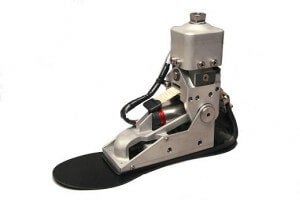
Someday soon, amputees will have more powerful limbs than those with their natural bodies. iWalk, a prosthetics company formed in 2006, is gearing up to provide the world’s first actively powered foot and ankle this year. Called the PowerFoot One, the prosthetic limb uses springs and a half pound lithium ion battery to provide human-like power. It gives the same push off the ground as a human foot, and can adjust to slopes, walking up and down steps, or hanging casually when you lounge in a chair. The PowerFoot One can even be adjusted using a Bluetooth enabled phone and (according to an interview in Forbes) will soon have an associated iPhone App. Along with lower limb prosthetics from other companies, the PowerFoot One is set to give amputees an ease of movement that’s nearly natural. Give iWalk enough time, and they’re likely to make it better than human.
PowerFoot One is advanced in its sensing as well as its motion. Three on board processors and 12 sensors allow the limb to make around 500 adjustments each second. These measurements are combined with a comprehensive library of known patterns of human foot movements. In effect, the PowerFoot One knows how you’re going to move before you have time to think about it. It’s not quite the artificial intelligence we’ve seen in other lower limb devices, but unlike the Proprio Foot from Ossur, the PowerFoot One is providing enough force to really augment movement, not just adjusting its position to match your gait. It’s very impressive.
The Department of Defense seems to agree. They’re interested in the PowerFoot One as a possible prosthetic for injured soldiers. In fact, a good portion of iWalk’s $10+ million startup capital was funded by the Veteran Administration and the US Army’s Telemedicine and Advanced Technology Research Center (TATRC).
But if there is one driving force behind PowerFoot One it’s the limb’s developer and first user, Prof. Hugh Herr of MIT. He’s the head of the University’s Biomechatronics group and a double leg amputee himself. His work has been incorporated into devices for prosthetic’s leader Ossur, and he was one of the founders of iWalk. Herr’s story is very remarkable for its bravery and determination, but it’s his vision for the future that is really impressive. According to Forbes, Herr envisions the upcoming century as one that blurs the boundaries between man and machine. The prostheses for amputees today will become the universally sought after bionic limbs of tomorrow.
Before that happens, however, there’s a small matter of money. The PowerFoot One will cost users an unspecified amount in the low five figures. Similarly enabled lower limb devices we’ve seen before have similar expenses. Upper body bionic prosthetics, which continue to trail lower limb devices, are still experimental and can cost many tens of thousands of dollars. Veterans in the US could see great financial support from the VA for these limbs but most amputees simply won’t have the budget for them. Give that time, though. As with all forms of advancing technology, bionic limbs should experience falling costs even as technology improves. Devices like the PowerFoot One may be too expensive for many right now, but its successors will hopefully become universal options for those who have lost a foot. And one day for those who still have their foot but want to improve it.
Often when discussing medical technology, Singularity Hub is asked about specific means for acquisition or participation in clinical trials. If you are an amputee interested in trying PowerFoot One or would like more detailed information, please contact iWalk directly at their website.
[image credit: iWalk]


